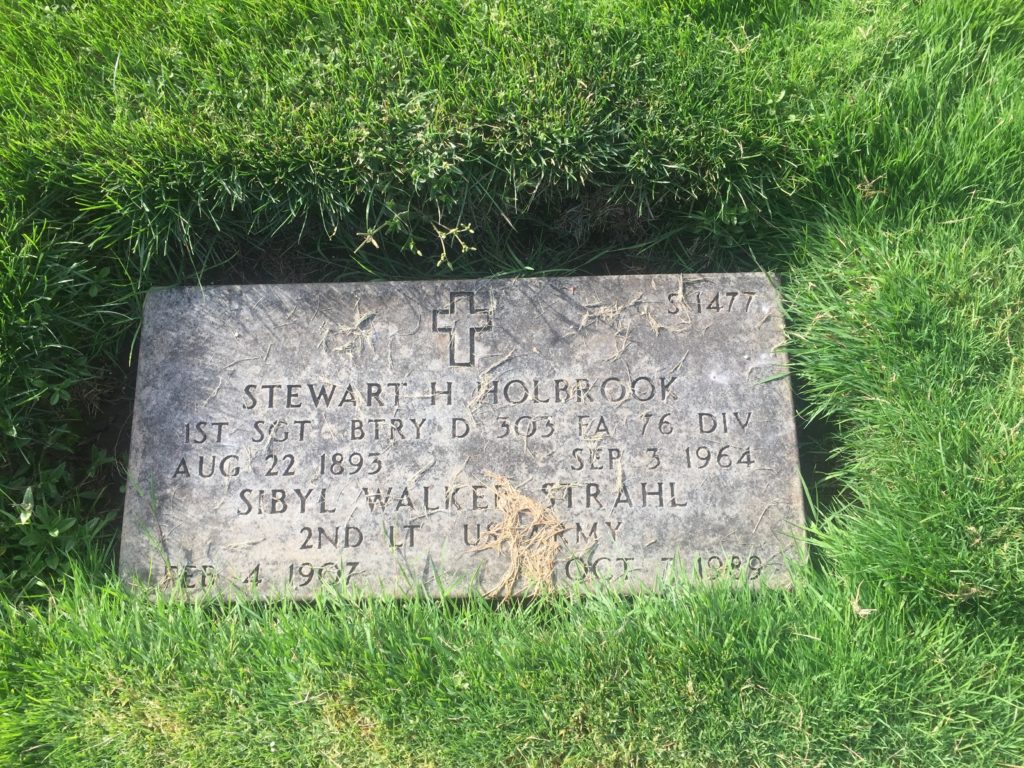Erik Visits an American Grave, Part 1,096
This is the grave of Stewart Holbrook.

Born in 1893 in Newport, Vermont Holbrook grew up there and in New Hampshire. In 1923, Holbrook moved to Portland. He was a working class guy and hadn’t really improved his financial situation over the years. He was 30 years and starting over. So he did what working class men did in the Pacific Northwest–he got a job in the timber industry. But at the same time, he was ambitious. He was a good writer and he knew it. He started writing and proved very good at it. Mostly, he wrote about the timber industry he was involved with. He was in World War I, though fairly briefly. He then found a job working for the Loyal Legion of Loggers and Lumbermen, which was the company union developed in World War I by the government to eliminate the IWW and solve the labor problems of the timber industry. During the 1920s, the industry kept it as a voluntary company union and through the 20s many top firms did remain involved in it. So he wrote for their publication, which was quite useful for my book research, though obviously one needs to take it with a gigantic salt lick. But that wasn’t all, Holbrook got work for real publications too, including The Oregonian, the main paper for the state.
By the 1930s, Holbrook was writing full time. But he hardly forgot where he came from. Holbrook became the bard of the logger. This sounds cheesy and these books don’t really hold up all that great today, but don’t underestimate his importance. He was a serious mid-century intellectual that had a national audience. His first book, and the one I know the best, Holy Old Mackinaw: A Natural History of the American Lumberjack, from 1938, did a lot to bring the history of American logging to light, with a somewhat romanticized emphasis on the toughness of the individual logger. MacMillan published it and it was a major sensation. Out of this, he became a frequent contributor to The New Yorker.
Holbrook’s books tended to be a combination of writing about industry and the men who worked it and biographies. Among his biographies were of Ethan Allen (1940 and again in 1949), Annie Oakley (1948), James J. Hill (1955), Davy Crockett (1955), and Wyatt Earp (1956). He also wrote Lost Men of American History in 1946 that highlighted people he thought needed more attention. As one can see, like many of his generation, Holbrook was pretty obsessed by the Old West. He also wrote a lot about his beloved Northwest, including books on the Columbia River (1956), Portland (1951), and a book of essays on his love for the region (1952). Holbrook’s histories were aggressively popular. He proudly used the term “lowbrow” to describe them. They are not the best of his books, not because they were popular but because they were poorly researched and have lots of factual errors in them. In the end, Holbrook was more interested in mythology than digging deep. His writing was known for its humor and for its championing of the everyday working man. That it was a white working man goes without saying since he didn’t really have the capacity (nor did most of society really) to see this is any other way.
Holbrook became deeply concerned with conservation as he aged. He saw Oregon and Washington become quite popular and their populations starting to grow. This has of course continued unabated through the decades since his death. He worried that a growing population would damage the Northwest’s beauty and solitude. Anyone who has tried to hike in the Columbia Gorge on anything but a Tuesday afternoon in November knows that there’s a lot to this. He wasn’t a modern-day preservationist. He identified with the older generation of conservationists such as Theodore Roosevelt or Gifford Pinchot. He was a logger after all.
Now, you’ve probably never heard of Holbrook. He’s completely unread today. In the end, he was a regional writer about a region that not many people cared about. It’s entirely possible that there could be some kind of revival for his non-history works. Every now and again, the Library of America does this with some largely forgotten writer. I’m reading through the Peter Taylor set right now, who I had never even heard of before. But I doubt it. Holbrook’s style doesn’t really translate well to the present. It’s hard to get past the hokiness and the Turner frontier stuff. That said though, you can’t overestimate just how important this guy who you’ve probably never heard of before was to midcentury letters.
Holbrook died in 1964, felled by a cerebral vascular hemorrhage. He was 71 years old.
Stewart Holbrook is in Willamette National Cemetery, Portland, Oregon.
If you would like this series to visit other writers of the mid-century era, you can donate to cover the required expenses here. Harper Lee is in Monroeville, Alabama and John Updike is in Plowville, Pennsylvania. Previous posts in this series are archived here.
